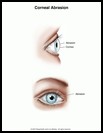
Corneal Abrasion
What is a corneal abrasion?
A corneal abrasion is a scratch on the surface of the cornea. The cornea is the clear outer layer on the front of the eye. Corneal abrasions can be very painful.
How does it occur?
Corneal abrasions can be caused by:
- A sports injury: This can happen in sports such as basketball or football when a player gets poked in the eye, or in tennis or racquetball when a player gets hit in the eye with the ball.
- Something gets in the eye: Splinters or tiny pieces of dirt may come out in tears, or a healthcare provider may need to remove it.
- Something scratches the eye: The eye may be scratched with something such as a fingernail, branch, piece of paper, or comb.
- Problems with contact lenses: Gas permeable contacts may become chipped or cracked and scratch the eye. Wearing contact lenses too long can also cause an abrasion.
What are the symptoms?
Symptoms may include:
- redness
- tearing
- feeling like there is something in the eye
- pain
- a scratchy feeling
- painful sensitivity to light
- blurry vision
How is it diagnosed?
Your child’s healthcare provider will ask about symptoms and ask if you know how your child’s eye was scratched. Using special eyedrops and a light that makes an abrasion easier to see, the provider will look at your child’s eye. The drops contain a dye that will make your child’s vision yellow for a few minutes.
How is it treated?
If something is still in the eye, your child’s provider will flush it out with water or remove it with a swab or needle (after numbing the eye with a drop of anesthetic).
Your child’s healthcare provider may:
- Give you antibiotic drops or ointment to use in your child’s eye for several days.
- Give you another medicine that dilates your child’s eyes and helps relieve pain and sensitivity to light.
- Tape an eye patch over your child’s eye to keep the eyelid closed. This helps to relieve pain.
- Place a contact lens over your child’s cornea to act as a bandage. The contact helps to speed up healing and reduces eye pain.
- Want to see your child often until the eye is healed.
Most corneal abrasions heal in a day or two. Larger abrasions will take longer. If symptoms last longer than that, see your child’s healthcare provider again because there may be a more serious problem.
Once the cornea has healed, your child can usually resume normal activities right away. If your child wears contact lenses, your healthcare provider may suggest waiting one week after the cornea has healed before your child wears his contact lenses again.
How can I help prevent a corneal abrasion?
- Make sure that your child always wears goggles, safety glasses, or eye shields when playing sports where the eyes could be injured.
- Follow your eye care provider's instructions for wearing and caring for contact lenses. Do not let your child wear contacts longer than recommended.

